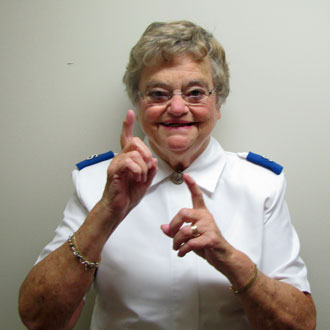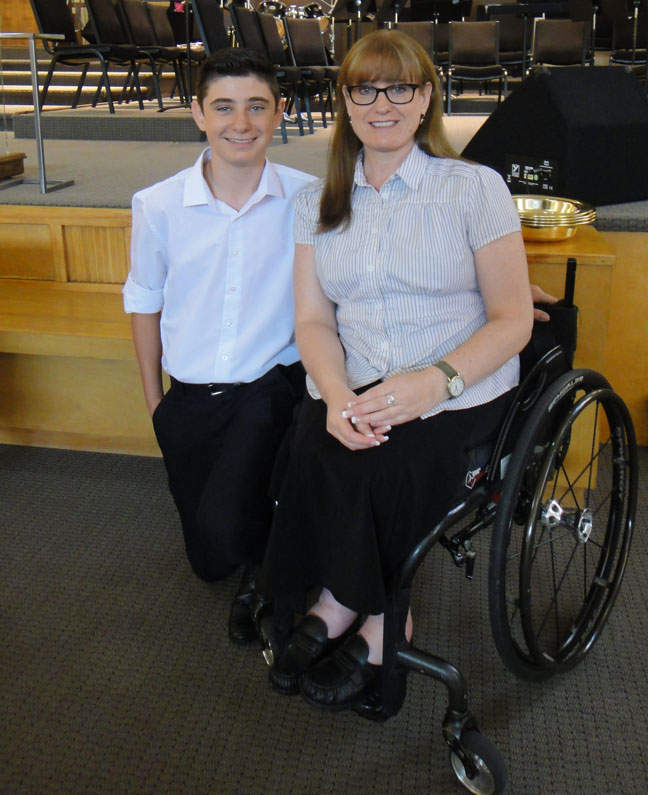“People don't treat me as someone who needs to be singled out in any way,” says Snow, who attends North Toronto Community Church. “I have felt extremely welcome.”
North Toronto has an older building, but the corps makes an effort to be structurally accessible. “The lift can be a little shaky at times, but it's something,” says Snow. “I was impressed by the automatic doors and lights in the washrooms.”
But not everywhere is as welcoming. One common flaw she has encountered in various venues is the seating arrangements for people who use assistive devices.
“We don't always want to sit at the back. You feel singled out,” says Snow. “Indented seating is great because you can sit among the congregation. It would be nice to have options everywhere.”
Greater Needs
For many of us, opening a door, walking up stairs or shuffling through a noisy crowd present no challenge. But for someone with a physical disability, these obstacles may be the difference between attending church or staying home.
Of the 3.8 million Canadians who reported living with a disability in 2012, one in eight also reported that they use assistive devices. With an aging nation and the increasing percentage of Canadians living with disabilities, it is expected that by the year 2051, Canada will see one in four people living past the age of 65, and with that comes
a population with greater physical needs.
Beverly Cooey, territorial health and safety manager for Canada and Bermuda, is dedicated to educating people about accessibility standards as she encourages ministry units to form progressive attitudes around codes and policies.
“We must ensure that we have standards in place for an inclusive, diverse environment,” she says. “And part of diversity is the acceptance of disabilities and making them a norm.”
Making Strides
In recent years, the community and family services office in Oshawa, Ont., has made a significant effort to be more inclusive.
“We looked at the future and thought about how we could comply with the Accessibility for Ontarians with Disabilities Act in years to come,” says Ivan Downey, director of community and family services.
Through a partnership with the federal government's Homelessness Initiative, the Army received donations to fund the installation of washrooms on the main floor of their building, automatic doors, an elevator, and the expansion of the waiting room and existing washrooms.
“Our clients love it. The elevator is a great thing for them,” says Downey. “Not only is the elevator good for our clients with physical disabilities, but also for anyone who uses the second-floor food bank and has to carry heavy food bags downstairs.”
In recognition of their efforts to improve their facility, Oshawa's community and family services received the Accessibility Improvement Award from the City of Oshawa in May 2010.
 Edna Dawe is a sign interpreter for St. John's Citadel
Edna Dawe is a sign interpreter for St. John's Citadel
At St. John's Citadel, N.L., services are made more accessible through a sign language ministry, which began more than 30 years ago. The corps uses sign interpreters to translate Sunday morning meetings for those who are deaf and hearing impaired.
“Everything is translated through sign even though we have PowerPoint,” says Major Brian Wheeler, corps officer. “Those who are deaf and hearing impaired stand up with the congregation and the interpreter, and they all sign together. That's how they sing.”
The corps also runs a Bible study for the deaf community where they gather once a month for a potluck and a translated study. “Some of them are members of the corps while others come to visit because their own church doesn't sign,” explains Major Wheeler.
“It has made our church community more aware of the needs of others,” he continues. “They're all part of the family even though there are some communication barriers.”
Captain Rick Zelinsky, corps officer at North Toronto, sees the story of the paralyzed man in the Book of Luke (see Luke 5:18-19) as a scriptural model for inclusivity.
“Just as the men skipped the crowd and lowered the paralyzed man through the roof to Jesus, our corps can improvise with the resources we have to make it work,” he says. “We may not always have the perfect solutions or the nicest elevator lift, but if we begin by making the effort, we can begin to make a difference.”
Attitude Barriers
Ignorance can kill a corps faster than a set of stairs. Sometimes attitudes in a church can unintentionally prevent people from attending.
“Attitude barriers are a lot more prevalent than physical barriers when it comes to people with physical disabilities,” says Cooey. “Quite often we see the barrier of people thinking 'we have always done it a certain way.' That's one we have tried to knock down.”
Being mindful of attitudes and behaviours can improve the quality of social interactions within the corps. These interactions extend beyond a Sunday morning meeting to church events, potlucks and other social gatherings.
It may seem harmless to pour someone's coffee or serve their plate of food, but these actions could diminish their dignity. “You may make them feel that they can't get food and can't be independent, when it's their legs and not their arms and brain that are not functioning,” says Cooey. She suggests asking, “May I help you?” instead of assuming they need assistance. This gives people with disabilities the option to decline help.
Snow has also experienced attitude barriers in a spiritual context.
“I sometimes feel apprehensive because, so often with people who have a disability, it is assumed that we need God more,” says Snow.
“Who needs God more, the man walking down the street in a suit or the woman rolling down the street in a wheelchair?” she continues. “Chances are your mind would go to the woman in the wheelchair because it seems like she doesn't have it as easy. We have to be cognisant that we all have struggles.
“We all need to broaden our social opinions about who needs God and why we're drawn to a place of worship.”
Innovative Solutions
Looking ahead as an organization, The Salvation Army aims to move forward and be proactive in its approach to being inclusive and welcoming. “We develop strategies at the national level and then educate people to make them aware so that they, in turn, will spread it on,” says Cooey.
“Churches are built from generations. As we move on through the generations, we learn more,” says Snow. “Education is vital for getting rid of barriers in the social environment.”
“I see The Salvation Army as a leader because it's built into our core values,” concludes Cooey. “We are compassionate and we are always looking for innovative solutions.”
Helpful Tips to Improve Accessibility
- When offering help to people with assistive devices, begin by asking, “May I help you?”
- Beware of using exclusive language. Replace common phrases such as “Please stand and join in worship” with “Those who can do so, feel free to stand and join in worship”
- Print hard-copy booklets of song lyrics for those with visual impairment. Include braille text
- If you do not have an automatic door, install a doorbell or ensure that an usher is available for assistance
- Reserve space at the back of the sanctuary while also reserving seats within the congregation for those using an assistive device
- Clear the aisles and an area surrounding the mercy seat to allow access for those using assistive devices
- Many platforms are not accessible. Place a microphone or a second pulpit with an adjustable microphone on the ground level for Scripture readings, testimonies, announcements and other speaking opportunities within the service
- At potlucks or fellowship gatherings, set out tables with fewer chairs to create space for individuals using walkers or wheelchairs










Leave a Comment